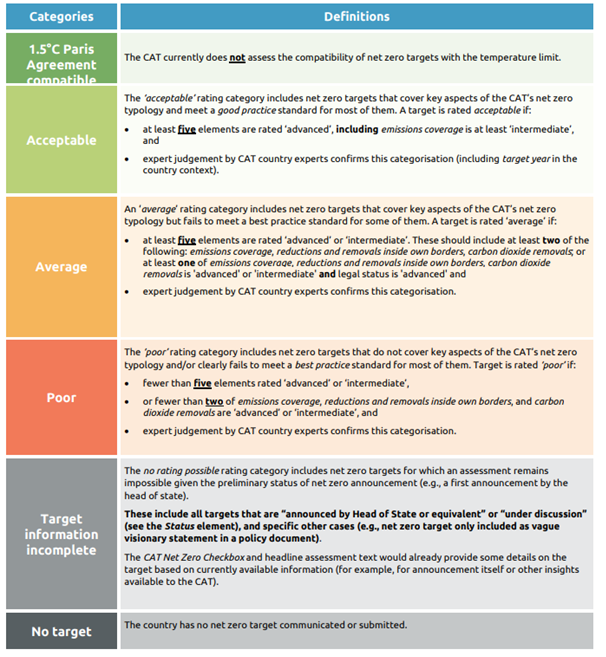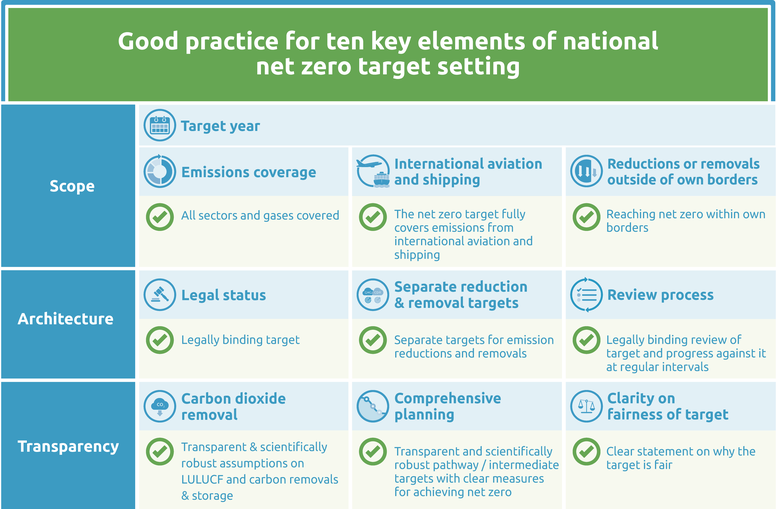Net zero targets
Introduction
Since the adoption of the Paris Agreement and the release of the IPCC Special Report on Global Warming of 1.5°C, a growing number of countries have committed to net zero emissions targets. As of March 2022, 33 countries and the European Union have set such a target, either in law or in a policy document. More than 100 countries have proposed - or are considering - a net zero target (ECIU, 2021).
This is in line with Article 4.1 of the Paris Agreement, which stipulates the need to “to achieve a balance between anthropogenic emissions by sources and removals by sinks of greenhouse gases in the second half of this century […]” (UNFCCC, 2015). Implementation of national net zero targets can play a crucial role in limiting global warming to 1.5˚C, which requires carbon dioxide (CO2) and other greenhouse gas (GHG) emissions to rapidly decrease to net zero around 2050 and 2070, respectively. After that, emissions should decrease to be net negative (IPCC, 2018).
Reaching net zero GHG emissions is more difficult than reaching net zero CO2 emissions, as reducing some sources of non-CO2 emissions towards zero remains very difficult, especially for methane and nitrous oxide from agriculture. Typically, net zero GHG emissions are achieved with significant negative CO2 emissions balancing the remaining GHG emissions (IPCC, 2018). There is also uncertainty in modelled scenarios around the pathway to - and timing of - global net zero and net negative emissions. The faster countries decarbonise, the lower the level of cumulative emissions released by the time global net zero is achieved, and the higher the probability of limiting peak warming to 1.5°C (Rogelj et al., 2019).
While it is encouraging that many governments are committing to net zero emissions, their targets vary in terms of timeframe, what GHG emissions and economic sectors are covered, whether the country intends to rely on removals and reductions outside its own borders, legal status, and other aspects. This has important implications for the strength of net zero targets, and whether they are likely to contribute sufficiently to reaching net zero emissions globally.
In this Climate Action Tracker (CAT) evaluation methodology for national net zero targets, we outline a design blueprint for transparent, comprehensive, and robust net zero targets. This blueprint contains ten key elements of good practice that governments setting net zero targets should consider.
We use these elements to evaluate the net zero targets that countries covered by the CAT committed to. The identified good practice for each of the ten elements can further serve countries in designing and enhancing their net zero targets. Note that the CAT Net Zero Methodology is specifically designed for national net zero targets and is not necessarily applicable for evaluating net zero targets set by subnational and non-state actors.
Overview of the rating elements
National net zero targets vary with regards to the target year; what emissions and economic sectors are covered; whether the country intends to use reductions or removals outside its own borders; the role of carbon dioxide removals; whether the net zero target consists of two separate reduction and removal targets; governance and planning processes; and fairness considerations. The CAT looks at ten key elements of each country’s net zero target to assess whether the target’s scope, architecture, and transparency meet what we define as good practice.
The CAT rates each individual element as “advanced”, “intermediate” or “poor”. The full methodology document provides more detailed explanation on each of the elements.
Headline evaluation

The headline evaluation aims to categorise existing net zero targets into broad categories to distinguish their level of comprehensiveness and, where possible, level of ambition. The headline evaluation explicitly does not assess whether a net zero target is aligned with the Paris Agreement’s 1.5°C temperature limit.
More information
More detail on this method and the list of references is available in the full methodology document.
Stay informed
Subscribe to our newsletter
